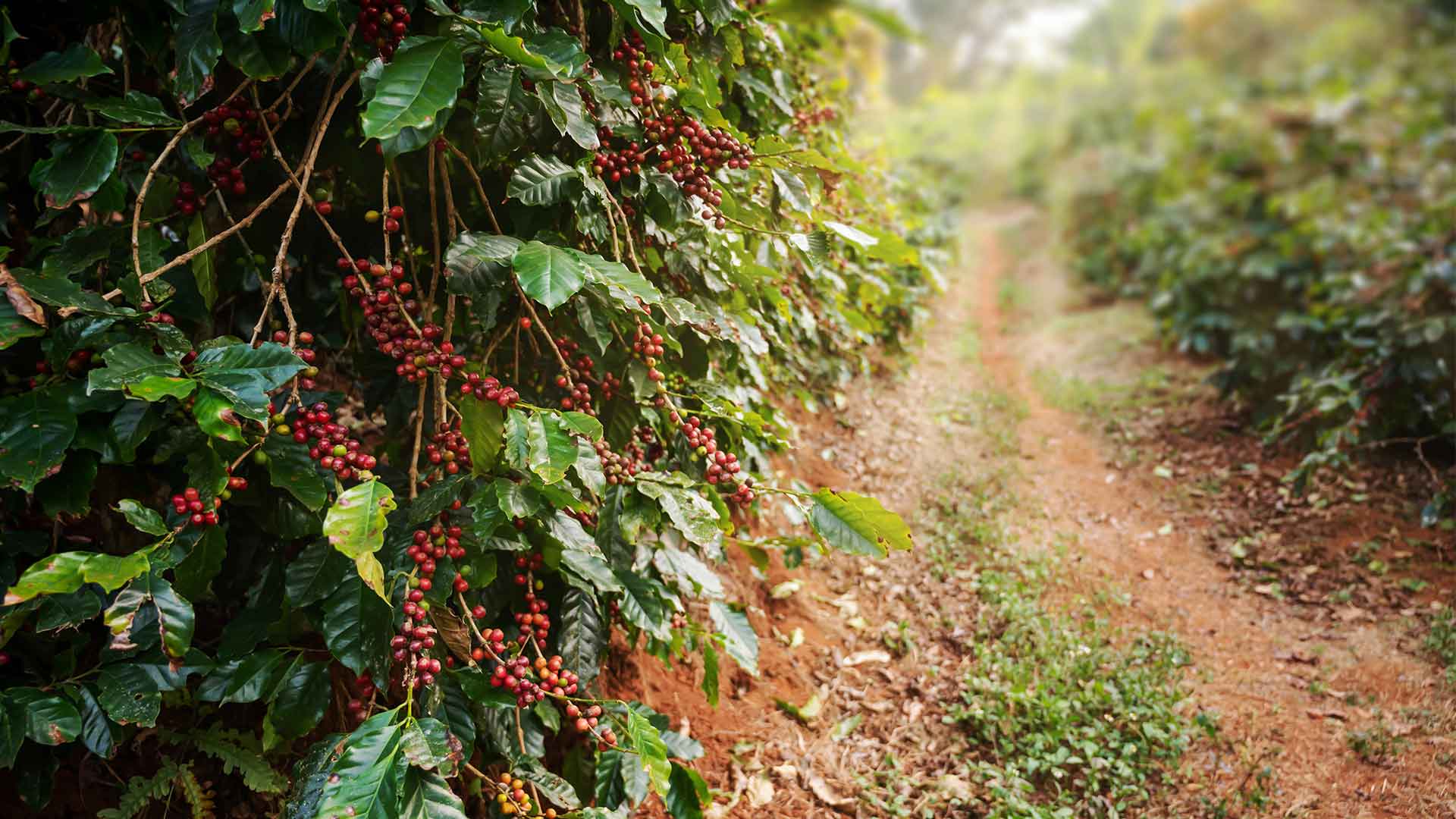Boron in Coffee Plants
Coffee is one of the most susceptible crops to boron shortage. Boron in coffee is needed for coffee cultivation to improve yield and support healthy growth via cell divisions and cell wall formation in association with calcium, water uptake, roots growth, growth of internodes, setting, calcium uptake, lower aluminum toxicity, and drought resistance.

Morning Joe
Americans on average drink several cups of coffee every day (Morning Joe). While one cup of coffee only contains 0.07 milligrams of boron, several cups makes coffee a top contributor of boron in the American diet. Coffee also contain additional minerals such as potassium, magnesium and niacin.
Research into Boron and Coffee
Boron deficiency can lead to the death of the terminal-growing point. The characteristic fan-like effect caused by secondary branches developing below the terminal buds is due to the death of the terminal growing point. The secondary stems often die quickly, leading to the death of the terminal portions of the new shoots in severe cases.
Muhammad Riaz published a study that was published in the Journal of Environmental Management. Boron’s role is crucial in decreasing aluminum toxicity in citrus, as demonstrated by Muhammad Riaz (et al. Boron is a regulator of multiple physiological processes. It can increase dry matter weight, plant length, and root length as well as leaves. This can be used for coffee or other plant species.
The study also shows a decrease in red mite bites (Tetranychus pyrugi). There was a correlation of boron to cyanidin production. Cyanidin is toxic to mites and is a type of polyphenol called cyanidin. Another study recently showed that coffee borer had a more negligible effect on leaves with high boron concentrations (Hypothenemus span>). Boron sources or isotopic fractionation can control the Isotopic boron composition of coffee beans in B translocation. Further study is needed on the process of B isotope reduction in coffee beans.
Boron Deficiency in Coffee Plants
(All research in this section was sourced from City University of New York CUNY.) Boron is one the most B-sensitive and responsive of all species (Brown & Shelp, 1997). Boron deficiency occurs in large numbers in Brazilian plantations. Correa et al. (1986). Higher B concentrations were found in coffee leaves than they were in stems or fruits.
Scientific laboratories discovered that fruit-bearing limbs had higher concentrations of Boron (compared to those with no fruits). The plant had the highest levels of Boron concentration during the rainy period, which is a sign that the nutrient’s transportation through the xylem takes place (Chaves. 1982)
Brazil recommends Boron fertilizer only when the soil has been extracted from hot water at 0.06 mg/dm-3 or less than 60 mg/kg-1 (Raij and Matiello, 1996). However, coffee trees’ reactions to B fertilizer were inconsistent depending on their year, source, and application method.
Lima Filho & Malavolta (1998) found a positive relationship in coffee branch length with B leaf concentrations. However, the dry matter yield did not correlate with B levels—moreover, Marubayashi et al. (1994). Marubayashi et al. Santinato et al. (1991) The B was sprayed onto the coffee leaves shortly after a weak harvest (September) and before main blooming (October). Their results showed a rise in coffee yields from higher fruit retention (30 % better than the control), but no response to B foliar-applied.

Boron deficiencies in coffee usually first appear in newly developed leaves. This is a common sign of immobile nutrients. As plant age and leafage increase, leaf B concentrations tend to rise. In some extreme situations, leaf B concentrations can increase with age. However, it can present a problem when attempting to manage B fertilization in coffee. Since the leaf’s xylem is a significant source of B, it may not be representative of the mature leaf being used for foliar diagnosis. The boron content of a mature leaf may not accurately reflect the status of growing tissues which require a constant supply of this mineral (Brown & Shelp, 1997 – see above)
The cell walls are responsible for more than 90% of B-deficit in plants (Matoh et al.;, 1992). Brown & Hu (1994), Matsunaga & Nagata (1996) also concluded that most plant B has a high pectin content in cell walls. B plays a critical role in the growth and mobility of tissues, so it needs to be maintained throughout the plant’s life, often through roots (Brown & Hu, 1994). Depriving a plant of B of its nutrient medium, even for a short time, can reduce growth. In Faba beans (Vica Faba), the xylems were deformed after being exposed to B deficiency for more than 24 hours. (Robertson & Loughman. 1974). A cotton deficiency with Boron can lead to necrosis in the xylem. Sanfuentes (2016) also reported that B-deficient cotton plants’ xylem vessel walls were thicker and had fewer vessels with an irregular perimeter. Moraes Dallaqua (1992) reported hypertrophy of the cortex cells and size modification and poor differentiation of vascular tissues in B deficient common bean. Thinner wall structures were also seen in tomato roots (Kouchi-Dallaqua, 1976 span>
A temporary B shortage in cotton shoots resulted in lower plant height and dry matter yields. It was also less likely that the crop would be able to grow well without foliar application. (Rosolem & Costa2000). The authors suggested that a temporary B deficiency in a plant that does not translocate can cause permanent injury once it is not fully grown after replacing B in the nutritional solution. This effect can be stopped by applying B to mature cotton plants during B shortages in the solution. This will likely prevent xylem malformation during deficiency periods (Robertson & Loughman 1975 span>
Considering a lack of correlation between B concentrations within leaves and fruits (Marubayashi et al. 1994; Lima Filho & Malavolta 1998), and inconsistent responses (Santinato et al. 1991; Almeida & Matiello 1996), as well a possible effect of xylem formation (Rosolem & Costa 2000), a temporary B shortage could lead to a decrease in redistribution.
To develop a rational fertilization strategy, we need to be more aware of the effects of B on plant anatomy. The purpose of this paper was to study the effects on leaf anatomy of two coffee varieties.
Why Coffee Plants Develop Symptoms
Terminal Dieback and the development of crinkled foliage towards the end or beginning of the wet season are both signs that the coffee plants may have a boron problem. These symptoms can be caused by reduced boron absorption from the dry topsoil layers.
Due to the decreased availability of soil-boron, symptoms may be more evident during flowering or after liming. Boron is generally used in coffee to prevent branch dieback and other symptoms.
Long Term Study into Boron on Coffee farms
A long-term investigation was carried out on coffee farms (2010 to 2016) to determine how Boron and micronutrients impact the yield of coffee.Source: ecofriendlycoffee.org. Boron, along with other micronutrients, is required in tiny quantities. Deficiency can be seen as a visual sign. After the visible symptoms have been expressed, the deficiency can be corrected by either applying the micronutrients to the soil or spraying it in the foliar of the plant. The deficiency will be updated by the regular application of micronutrients in sufficient quantities.
Addition of Boron 200gs. and Rexolin (200g) to a regular schedule foliar nutrients containing 1kg Mono Ammonium Phosphate was made. At industrial manufacturing plants, the 500g of Boron 19 and the surfactant in 200-liters of water were used at a rate of 3 barrels an acre. Experts determined that boron fertilizer in coffee was developed over five years to optimize growth and yield parameters.





